
|
Olympus C-5050Z: accessories |

| My other pages related to the Olympus C-5050Z, C-5060WZ, and X-7070WZ |
|
Here are some remarks on accessories which you may (or may not) find useful with the C-5050Z. Note that this article is specific to the '5050 model; accessories for the C-5060WZ are discussed in another page. | |
|
An external flash: This is a must if you do more than just some occasional flash shooting indoors. Some models I found suitable for the C-5050Z are discussed in a separate article.
Of those, the (discontinued) Olympus FL-40 provides through-the-lens exposure automation, smooth operation (the camera takes over the control), and pleasing results, although it is rather big and heavy compared with the camera itself. The FL-40, while still available, has been replaced by the new FL-50 model. It integrates well with C-series cameras, but the new features are applicable only to the E-10/E-20 SLRs. A smaller version, FL-36, provides half of the light output of the FL-50 and uses only two AA batteries, but retains the full TTL automation and all the niceties of the bigger model, being just the right size for the camera. The FL-36 is my choice for the C-5050Z, and it is described in detail in a separate article. The FL-20 unit (shown) also provides dedicated operation, including TTL auto, with the C-5050Z. It is shirt-pocketable, but at the expense of bounce, tilt, and zoom capabilities, and its guide number is only 20 m (this is still four times the light output of the built-in flash). |
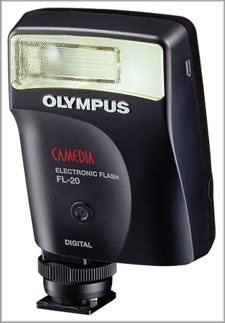
|
|
Extra storage: any SmartMedia (up to 128MB), CompactFlash (Type I or II) up to 2 GB, or xD-Picture (up to 512 MB)card will work; so will the MicroDrive (except for the very old, 340 MB model). Actually, I would recommend investing into a 512 MB xD, and at least a 1 GB CompactFlash.
See also my article on card writing speeds. Update of August, 2006: The SmartMedia format is long dead. You may keep any of these in your bag just in case you run out of storage. CF cards can be used up to the 2 GB capacity, but not higher, as the '5050 does not support the FAT-32 directory format. Still, with the SanDisk Extreme III the '5050 is a speed champion in its class, writing a raw file in just three seconds. The new "M" and "H" xD-Picture cards will work with this camera, but only up to 512 MB, according to Olympus (I haven't tried them out). |
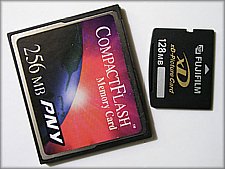
|
|
NiMH batteries and charger: You need three sets (four batteries each) of 1800 mAh or higher capacity, and a good charger (the one included with the C-5050Z is a simple model, although convenient for travel).
The Maha MH-401FS has very good press; it charges from one to four AA (or AAA) batteries in a slow (6 hours) or fast (100 minutes) mode, the former being more gentle on the poor little things. When done, it switches into a trickle mode, so that batteries are not overcharged. There is a separate circuitry for each battery, which will extend their lives, as each is treated individually as needed. Check the review by Dave Etchells of the Imaging Resource. I bought the MH-401FS in a kit with an extra power supply; not only much smaller than the (110V only) standard brick which comes with it, but also accepting any voltage from 100 to 240V; useful when traveling. You may save a few dollars buying the older Maha MH-C204F (see my E-10/E-20 accessory page), which is almost as good, but has only two sets of circuitry. I have used two of those since mid-2000, and even my oldest NiMH batteries are still OK, after almost three years of heavy use. Both chargers and batteries can be purchased from Thomas Distributing, where you can also find lots of useful information on the subject; I wouldn't think of buying them from anyone else. |
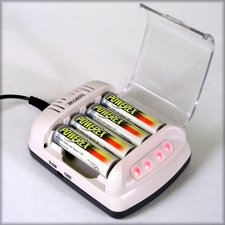
|
|
Lens adapter tube. As mentioned in the review, the collapsible lens may use some mechanical protection; the optional CLA-1 lens adapter from Olympus will also allow you to use filters and other lens attachments; this will also require a 43-46 mm step-up ring.
A better alternative is the Tiffen OLYC3000AD lens adapter: it has a nicer finish, matching the camera, and does not require a step-up ring to be used with filters. Both models are discussed in a separate adapter article. |
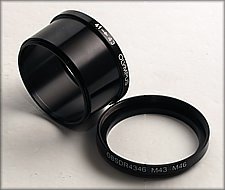
|
|
Filters. Because of the automatic color balance, filters are less useful with digital than with film cameras. Still, you may want to use an almost-clear UV filter as a lens protector, if you do not mind the extra bulk of the lens adapter tube you will also need. (Use 43 mm for the Tiffen tube, 46 mm for the Olympus one.)
You may also choose a polarizer to enhance colors, eliminate reflections, and darken the sky (doing that in postprocessing is not the same). Because the '5050 does not put any semi-transparent surfaces in the light path, you do not need a circular polarizer; a linear one will be equally good at half the price. Remember that you will have to use the LCD monitor to adjust and judge the effect of a polarizing filter; not too convenient. |

|
|
Lens attachments from Olympus: in 2003 Olympus released two new accessory lenses for the C-5050Z (matching equally well all 40x0, 30x0, and 20x0 cameras).
The first one is TCON-17, providing a focal length multiplier of 1.7x, i.e. to the film-camera equivalent of almost 180 mm at the zoom long end. Clearly, this is better than the 150 mm provided by the older TCON-14 (see below), and the lens is significantly smaller and lighter than the TCON-14B (ditto). As my samples show, this lens is a strong performer, in spite of a quite significant focal length multiplier. |
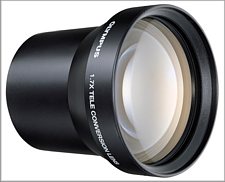
|
|
The second one, WCON-07, has the multiplier of 0.7x, bringing the wide-end focal length to the equivalent of 24 mm. This is what I consider the most useful wide angle, and the lens seems to be optically quite good.
I bought both lenses in May, 2003 at B&H , priced at $120 (TCON-17) and $160 (WCON-07); as of June, 2003, the B&H prices went down ($100 and $125), but the dealer is out of stock. A small review of these lenses, including image samples, is also available. |
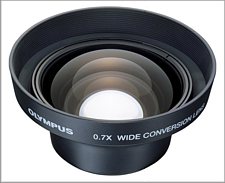
|
|
Older Olympus lens attachments: the ones which worked with the C-30x0Z and C-40x0Z will also fit the '5050: WCON-08 (shown, sold as WCON-08E on some markets), making the lens equivalent to 28 mm at the wide end, and TCON-14, extending the tele by 1.45x, to 150 mm. WCON-08 has a 55 mm rear thread, while TCON-14 uses the thread of 46 mm. I have not used either of these two.
The fish-eye attachment from Olympus will not work on the C-5050Z, and the MCON-40 macro attachment (+2.5 diopter) does not make sense in view of the new "super macro" capability. |
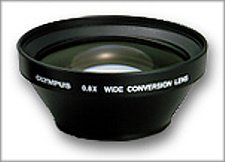
|
|
Raynox offers five lens attachments working with the '5050: .25x full-frame fisheye (shown), .72x (25mm), 1.54x (161mm), 1.80x (189mm), and 1.85x (194mm). Their Web site provides quite complete information, together with samples taken on a '5050 (unfortunately, reduced in size).
The fisheye (62mm thread) was primarily intended for the E-20, check my review. I bought it in spite of the so-so quality of their other lenses I knew or heard about, and was nicely surprised. Raynox lenses are sold in the States by Digital Distributors, and as of January, 2003, they had the .25x fisheye ($400), .72x ($90), and 1.85x ($130). |
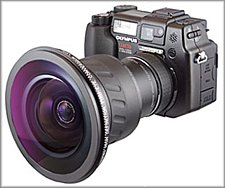
|
|
E-10/E-20 attachment lenses. The E-10/E-20 auxiliary lenses fit the '5050 via a 62-mm step-up ring, showing no vignetting and no focus problems.
One lens, TCON-14B (shown), multiplies your focal length by 1.45x (up to EFL=150mm); the other, WCON-08B — by 0.8 (28mm). They both work only at the respective ends of the zoom range, so what you really get from each is a single focal length combination. I expect them to perform equally well on the '5050 as on cameras for which they were intended; the test shots show good image quality. Whether you want to carry extra weight with a compact camera, is another story. Actually, unless you already have the E-10/E-20 lenses, I would recommend the WCON-07 and TCON-17 mentioned above. |
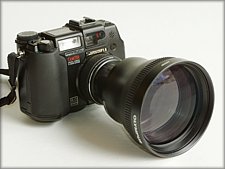
|
|
The FDL-01 LCD monitor hood. While the outdoors visibility of the 5050's monitor is somewhat better than that of the previous C-series cameras, it can be improved by use of a hood, shading it from the bright light. The good news is that this accessory, originally available only in Japan, is now being sold by a number of U.S. vendors, including B&H and Adorama. It fits both the '5050 and the new C-8080Z.
There are third-party alternatives available on the market, but none of them seems to be really matched to the camera, and I decided against trying any. |
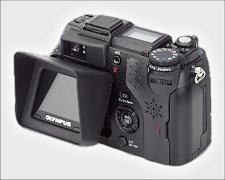
|
|
AC power supply. The '5050 accepts the same C-7AU AC adapter as many other Olympus cameras, including the C-30x0 and E-10/E-20. The adapter works only with one voltage (there are two versions: 100-120V and 200-240V). I bought mine about three years ago and used it twice. Save your money.
External power pack. Also not worth bothering with, I think. The camera has a very good battery life, and having a spare set of NiMH AA's in your pocket is more convenient. |
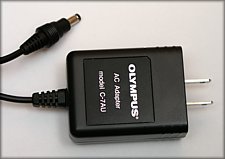
|
|
Tripod. You will need one in order to utilize the low-light capabilities of the C-5050Z. Most probably you will not want to lug around a 12-pound Manfrotto.
I always carry a Slik U-212 in my trunk, one of the best general-use tripods. It may be, however, too much for the '5050; I often use the tiny (1 lb, but extending up to 33 inches) Slik 450G. The problem is that it may be not easy to find (discontinued?). If you do not need a higher vantage point, check out the ingenious Cullmann Mini Magic (shown), nicely made, folding flat to fit into the side pocket of a camera bag, extending to 22 inches, and sporting a ball head. The latter, although not in the Arca-Swiss league, operates smoothly and is more than capable to hold a '5050, plus a 300g (11 oz) auxiliary lens without any slippage. The '5050 offers outstanding macrophotography capabilities. These often are utilized in table-top and/or low-angle applications, for which a very short, but reasonably sturdy, tripod is useful. After checking out a number of very portable, ingenious, but shaky alternatives, I settled down (again!) on a Slik Mini-Pro II with a panorama head. The platform tilts up/down and rotates, but does not tilt sideways, but you do not expect that from a panorama head this small, and as long as you are not shooting vertical frames, you'll be OK. Here you can see His Royal Cuteness fully extended to its maximum of 22 cm (that's less than 9 inches); the minimum elevation is about 15 cm (6 in). To see the Mini-Pro in action, check my '5050 macro mode article. At less than $30 you should get one just as a conversation item. |
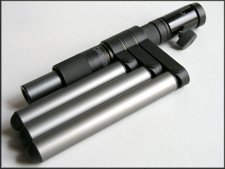
|
| Underwater housing — if you are into those things. The PT-015 underwater housing for the '5050 is available at $200 or so (less at some places). The housing is rated up to 40 m; it provides access to all camera controls, and with the new slave flash capability of the camera, an external strobe will be easy to use. (Don't ask me for more on this, as I'm not an expert in underwater photography.) |
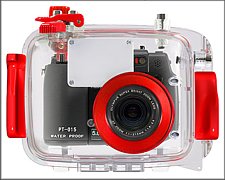
|
|
The Short Courses book on the '5050. Here is a better alternative to the abysmally bad Olympus manual. The author, Dennis Curtin, is an experienced photographer and writer, with credentials going back to the silver-halide era; knowledgeable in photography, digital or not, and fluent in writing (neither of which can be said about the Olympus' manual writers).
The book, available both printed ($20) and on a CD-ROM, is addressed mostly to beginning-to-intermediate users, but many of the more advanced ones may also find it useful and enjoyable. The Short Courses Web site, in addition to books dedicated to particular camera models, also offers a number of those dealing with general aspects of digital photography, and with on-demand production cycles much shorter than for brick-and-mortar publishing houses, the contents is always up-to-date. |
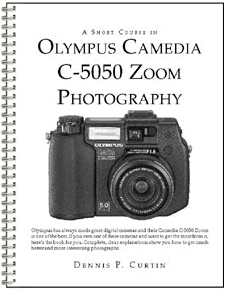
|

| My other pages related to the Olympus C-5050Z, C-5060WZ, and X-7070WZ |
| Home: wrotniak.net | Search this site | Change font size |
| Posted 2002/11/25; last updated 2006/08/22 | Copyright © 2002-2006 by J. Andrzej Wrotniak. |